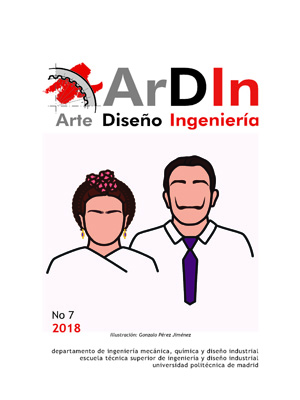El diseño gráfico como herramienta para la representación de la identidad visual y la interacción en el aula = Graphic design as a tool for the representation of visual identity and interaction in the classroom
DOI:
https://doi.org/10.20868/ardin.2018.7.3758Keywords:
Diseño gráfico, Identidad, Emoción, Graphic Design, Identity, EmotionnAbstract
Resumen
Este artículo está basado en una experiencia real, didáctica y significativa, realizada en un entrono virtual, en la que trabajamos el diseño gráfico aplicado a la creación de identidades visuales desde el punto de vista de la representación de personas en lugar de empresas o entidades. Gracias a esta actividad hemos podido aplicar diferentes estrategias innovadoras, como la gamificación, para el correcto desarrollo de una tarea que incluye la adquisición de conocimiento teórico-práctico, la reflexión sobre la identidad visual, la interacción entre los distintos miembros de la experiencia (estudiantes y docente) y la motivación del entretenimiento. Para una mejor comprensión, de la experiencia y la actividad, conoceremos las necesidades de las que surge la elaboración de la propuesta didáctica, el desarrollo de la misma, los principales fundamentos teórico-visuales en los que se apoya el aprendizaje y la valoración de la experiencia desde el punto de vista del docente y desde los estudiantes (participantes de la experiencia).
Abstract
This article is based on a real and significant didactic experience, realized in a virtual environment, in which we work the graphic design applied to the creation of visual identities from the point of view of the representation of people instead of companies or entities. Thanks to this work we have been able to apply different innovative strategies, such as gamification, for the correct development of a task that includes the acquisition of theoretical-practical knowledge, reflection on visual identity, interaction between the different members of the experience (students and teacher) and the motivation of entertainment. For a better understanding of the experience and the task, we will know the needs of which the elaboration of the didactic proposal arises, his development, the main theoretical-visual foundations in which the learning is supported and the valuation of the experience from the point of view of the teacher and from the students (participants of the experience).
Downloads
References
Argüello, J. (2005). Identidad e imagen corporativa. Córdoba: El Cid Editor.
Blázquez Entonado, F. y Alonso Díaz, L. (2009). Funciones del profesor de E-Learning. Pixel-Bit. Revista de Medios y Educación, Nº 34, 205-215.
Borrás, O. (2015). Fundamentos de la gamificación. Madrid: Universidad Politécnica de Madrid.
Català Domenech, J. M. (2008). La forma de lo real. Introducción a los estudios visuales. Barcelona: UOC.
Emdin, C. (2013). Enseñemos a los profesores a hacer magia. TED.
García, M. (2011, 11, abril). Hablemos con propiedad: logotipo, isotipo, imagotipo, isologo, imagen corporativa, identidad...
González Solas, J. (2004). La identidad visual. Area abierta, Nº. 8.
Maeda, J. (2006). Las leyes de la simplicidad. Barcelona: Gedisa.
Meggs, P. B. y Purvis, A. W. (2009). Historia del diseño gráfico. Barcelona: RM Verlag.
Norman, D. A. (2005). El diseño emocional: por qué nos gustan (o no) los objetos cotidianos. Barcelona: Paidós.
Sánchez i Peris, F. J. (2015). Gamificación. Education in the knowledge society (EKS), Vol. 16, Nº. 2, 13-15. DOI:http://dx.doi.org/10.14201/eks20151621315
Teixes, F. (2014). Gamificación: fundamentos y aplicaciones. Barcelona: Editorial UOC.
Downloads
Published
Issue
Section
License
ArDIn does not charge authors for processing or publishing an article and provides immediate Open Access to its content. All content is available free to the user or their institution. Users are permitted to read, download, copy, distribute, print, search or link to the full text of articles, or use them for any other lawful purpose, without prior permission from the publisher or author. This is in accordance with the BOAI definition of open access.
- Authors retain the copyright and grant to the journal the right to a Creative Commons attribution / Non-Commercial / Non-Derivative 4.0 International (CC BY NC ND) License that allows others to share the work with an acknowledgement of authorship and non-commercial use.
- Authors may separately establish additional agreements for the non-exclusive distribution of the version of the work published in the journal (for example, placing it in an institutional repository or publishing it in a book).
Unless otherwise indicated, all contents of the electronic edition are distributed under a Creative Commons license.













